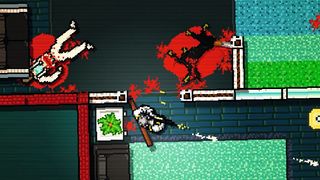
Many tools have been released over the years that claimed to make game development accessible to all. Software like Klik ‘n’ Play and DarkBASIC promised an easy route into game design, either through simplified programming languages or avoiding coding altogether. But there’s a difference between making game design accessible, and making professional game design accessible.
That’s where the other apps fell short, and where GameMaker: Studio is different. “I think that when we released Studio, the product changed and the user-base changed,” says Stuart Poole, head of production at YoYo Games, the makers of GameMaker: Studio. “People are now using this as a tool to make a living.”
Once a hobbyist development tool, lately GameMaker has formed the basis of several massively successful games, including Hotline Miami, Nuclear Throne, and the original version of Spelunky. Since 2012 its user-base has grown significantly, attracting professional programmers to its simple interface alongside curious first-timers. This success hasn’t come quickly or easily. For almost a decade GameMaker was supported by just one person, and its lengthy and somewhat eccentric development means YoYo Games has spent the last few years working with one hand tied behind its back. Nevertheless, GameMaker seems, finally, to be making its mark.
GameMaker was created in 1999 by Dutch computer scientist Marc Overmars. Originally conceived as a 2D animation program called Animo, GameMaker gradually evolved into a simple-to-use game-design toolset.

The core of Overmars’ idea was to make game design simple, and in pursuit of this he created the two features which remain most prominent in GameMaker today. Its drag-and-drop interface allows users to quickly put together simple 2D games with no knowledge of coding required (technically GameMaker can build 3D games, but few developers have explored that avenue). Through a simple series of button presses, you can define actions such as movement and jumping, and attach those actions to objects in the game world. For more confident users who want greater control, GameMaker facilitates programming through its GML scripting language, which combines colour-coded commands with rigorous error-checking and a detailed help library to make coding as straightforward as it can feasibly be.
For the best part of a decade, Overmars worked on GameMaker alone, chipping away at updates and fostering a small but amiable community of enthusiasts. Then in 2007 he partnered with Dundee-based outfit YoYo Games, with the intent of expanding GameMaker’s potential from getting people interested in game development to getting them building and releasing full commercial games.
For the best part of a decade, Overmars worked on GameMaker alone.
“What we had before was that folk would kind of grow up with GameMaker, and then they would hit this ceiling,” says Mike Dailly, head of engineering at YoYo Games. “Whether it was just they felt they were struggling with it or ‘it’s time to grow up and use a big-boy’s tool now’, and then they would move on. With GameMaker: Studio, we made a conscious effort to get rid of that ceiling so you could just keep going.”
The biggest gaming news, reviews and hardware deals
Keep up to date with the most important stories and the best deals, as picked by the PC Gamer team.
Released in 2012, the development of GameMaker: Studio involved several threads. Prior to Studio, GameMaker could only run games on Windows, so the team at YoYo Games wrote a new runner component to make it compatible with other platforms. They also designed a new compiler component to connect the maker and the runner, so games didn’t just compile their entire source-code on start-up, (making them extremely vulnerable to piracy). Lastly, they added a host of new features to the Maker itself, including a room editor for the quick construction of 2D environments. “There was a couple of hundred thousand lines in the original, and we’ve added a million and a bit with Studio,” says Dailly.
Most Popular

